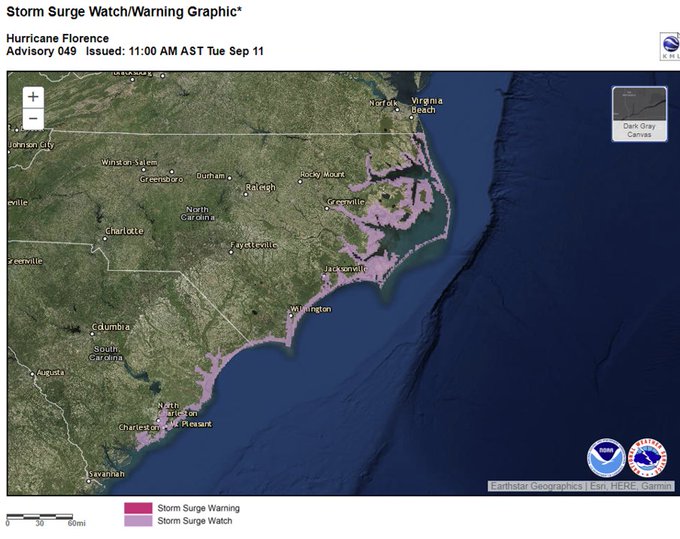Hurricane Florence is expected to develop into a category 5 storm by Wednesday evening becoming an “extremely dangerous major hurricane through Thursday night,” the Hurricane Center reported today. “Hurricane-force winds now extend outward up to 40 miles from the center and tropical storm-force winds extend outward up to 150 miles.”
Storm surges will reach up to 12 feet in some areas along the coast. Read the public advisory issued by the National Hurricane Center here.
Here’s what you need to know:
1. What Are Storm Surges?

According to the National Ocean Service, a storm surge is “the abnormal rise in seawater level during a storm, measured as the height of the water above the normal predicted astronomical tide.”
“The amplitude of the storm surge at any given location depends on the orientation of the coast line with the storm track; the intensity, size, and speed of the storm; and the local bathymetry.”
Florence is predicted to make landfall along the south or middle of North Carolina’s coast, “but the worst of the storm surge may occur further north, near the city of New Bern,” PBS reported. The storm surge will likely spread several miles inland along the Neuse and Pamlico Rivers, extending to Greenville, North Carolina.
The National Hurricane Center warned that storm surges coming from Hurricane Florence could reach up to 12 feet along the North Carolina coast between Cape Fear and Cape Lookout and anywhere from 5 to 8 feet between Cape Lookout and the Ocracoke Inlet.
Storm surges reaching 4 to 6 feet are also possible from Murrell’s Inlet, South Carolina, to Cape Fear, North Carolina, and from Murrell’s Inlet to Edisto Beach in South Carolina.
2. Hurricane Florence is Currently a Category 4 Storm, But Predicted to Reach Category 5 Before it Hits The Carolinas Late Friday
Hurricane Florence is currently a category 4 storm with winds already reaching 140 miles-per-hour and predicted to increase. Weather services report Florence will likely make landfall somewhere in the Carolinas late Friday or early Saturday. High winds are predicted to carry in a catastrophic storm surge that will move inland for up to two days.
Tropical storm-force winds around 40mph should arrive 12 hours before the storm. Hurricane Florence has winds extending 150 miles from its center.
President Donald Trump, Vice-President Mike Pence and Homeland Security Secretary Kirstjen Nielsen are being constantly updated on the storm’s progression. President Trump says, “They haven’t seen anything like what’s coming at us in 25, 30 years, maybe ever. It’s tremendously big and tremendously wet.”
3. Areas Under Storm Surge Watch Include The Entire Coast of South Carolina And Some Coastal Areas in North Carolina And Virginia

On the National Hurricane Center’s website, you can find a map highlighting the areas likely to be impacted by Hurricane Florence’s storm surge. Mandatory evacuations have been ordered for those living in South Carolina’s coastal areas.
South Carolina Govenor Henry McMaster issued a mandatory evacuation for Charleston, Berkeley, Dorchester, Georgetown and Horry counties.
Some coastal areas in North Carolina and Virginia have received mandatory evacuations as well. So far, Beaufort, Dare, Pamlico and Tyrell counties have been evacuated in North Carolina, also its Atlantic, Indian, Emerald Isle, Pine Knoll Shores, Ocracoke, Carolina, Kure, Wrightsville, Topsail, Currituck Outer Banks, Oak Island, Holden beach areas.
“These waves may be nothing like you’ve ever seen,” Governor Ray Cooper of North Carolina told ABC News.
Virginia has issued a few evacuations as well:
“Conditions along the South Carolina-North Carolina coast will rapidly deteriorate starting late Wednesday,” weather reports say.
4. Power in The Affected Areas May be Out For Weeks; Flood Warnings Have Been Issued in Some Inland Areas
“Life-threatening flooding is likely from a prolonged and exceptionally heavy rainfall event,” the National Hurricane Center said in a report. Heavy rain is predicted to extend inland “over the Carolinas and Mid Atlantic for hundreds of miles.”
Most weather reports say to prepare for major damage to homes and to expect trees along the coast to be snapped and uprooted. “Even in nearby areas where the storm doesn’t make landfall, rough seas and beach erosion are highly likely,” reported the Atlanta Journal-Constitution.

30-40 foot waves are expected to hit the coast, flooding inland areas.
Flood waters could reach up to 8 feet above ground along the coast where the Hurricane Center says the “largest and most destructive waves” will be.
“In North Carolina particularly, the barrier islands of the Outer Banks only leave a few inlets for water to be let out once the heavy rainfall and storm surges push water inland – further intensifying the impact of flooding in the area,” Joel Cline, a tropical program coordinator with the National Weather Service told Fox News.
The National Hurricane Center predicts up to 20 inches of rain in parts of the Carolinas and Mid-Atlantic states from the time the storm hits until early next week. See if your county has been issued a flash flood advisory.
5. Live Map: Track Hurricane Florence
As of Tuesday morning, the storm was 900 miles southeast of North Carolina’s coast, moving 16 miles per hour. Governors in North and South Carolina, Virginia and Maryland, and the mayor of Washington D.C. have declared states of emergency. President Donald Trump has authorized federal funding to assist with preparation for the storm’s impact.
Officials are urging residents to evacuate and to stock up on nonperishable food, water, medication, cash and toiletries.
If you are in South Carolina, there are hotlines you can call that will give you all evacuation information and steps on how to prepare.
Berkeley County: 843-719-4166.
Dorchester County: 843-832-0393 or 843-563-0393
Charleston County 843-746-3900
The S.C. Emergency Management Division hotline: 803-737-8500
This article is constantly being updated.

